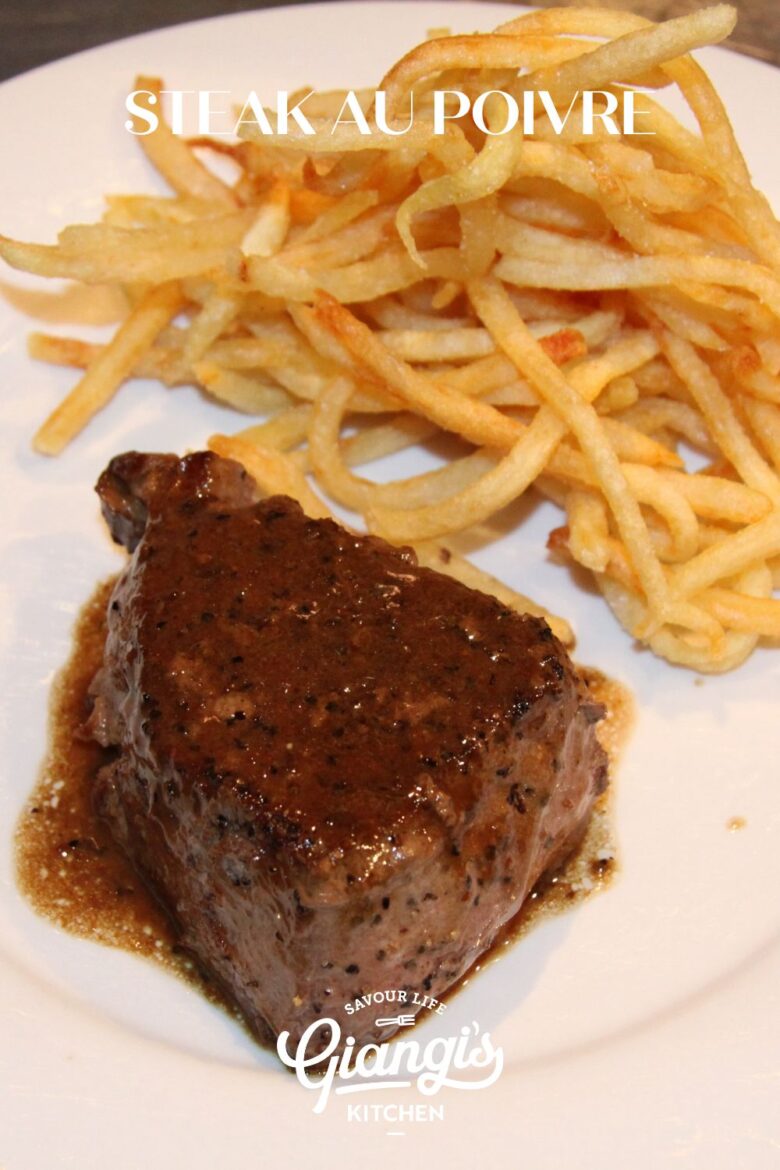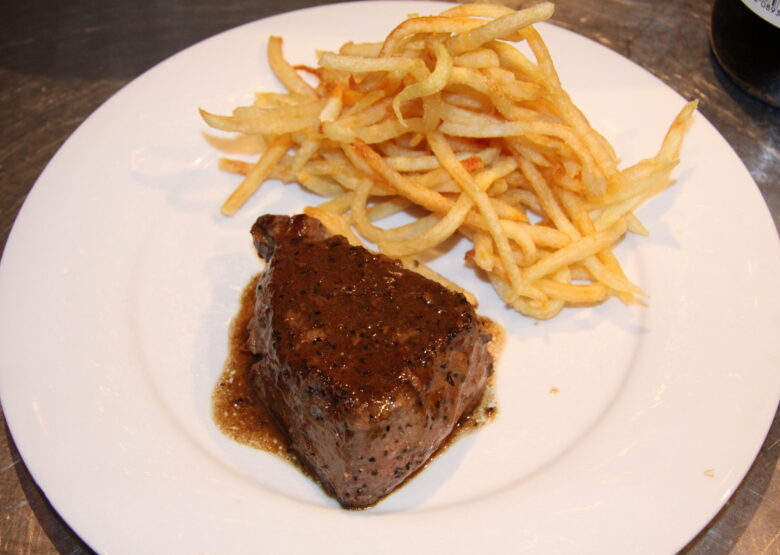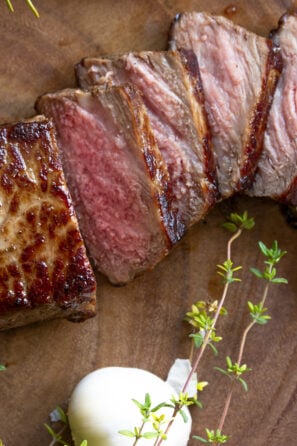Steak au poivre. It’s a classic French dish. As someone who grew up in France, I can tell you firsthand that Steak, Frites, and Salad are more than just a meal; they’re a staple.
It is the kind of dish that feels both everyday and special, rustic yet refined. With Bastille Day just around the corner, I decided to celebrate a little early with this beloved trio. And honestly, who’s ever complained about a two-day celebration?

Steak au Poivre has long been a favorite in French kitchens and bistros alike, with as many versions as there are chefs. In my home, we keep it classic: no heavy cream, just a robust pan sauce made with stock that lets the peppercorns shine.
Subscribe to Giangi's Kitchen!
Get my FREE email series: 5 Days of Easy Elevated Recipes plus a weekly newsletter!
I prepare my steak rare, the way I was taught and the way I prefer it, but if you enjoy yours more done, a simple adjustment—finishing it in a lower-temperature oven—will give you a perfect result without overcooking or burning the pepper crust.
This recipe reflects both my roots and my taste, and I am excited to share it with you. Whether you’re celebrating Bastille Day or simply craving a bit of French flair at your table, this dish never disappoints.
Most of all, please do not leave the French fries unattended, as they tend to disappear around little ones as well as around big ones.
In this Article
- Why you will love this recipe
- What is steak au poivre?
- A Personal Story
- Ingredients needed to make this recipe
- Equipment Needed
- How to make your steak au poivre
- Pro Tips
- TIPS on Cooking with alcohol
- What dishes can you enjoy with this pepper steak?
- Storing and Reheating
- Steak Au Poivre Frequently Asked Questions
- If you enjoy this steak au poivre recipe, you may want to try my other recipes.
- Steak au Poivre
Why you will love this recipe
Chef-approved – by my 30-plus years of restaurant ownership and a Michelin-accredited Chef Elaine from Epicurean Flow. See the personal story below.
Easy – takes no time at all to prepare this recipe.
Your guests will be mesmerized – This recipe is restaurant-worthy, if not better, if I may say so myself.
Perfect date dinner – impress that special someone with this steak, and the sky is the limit.
What is steak au poivre?
A classic French dish, steak au poivre, meaning steak with pepper, is typically filet mignon that is coated with coarsely cracked peppercorns and then seared in a pan.
At the serving time, a sauce is prepared that consists of shallots, sometimes heavy cream, and brandy or cognac.
Filet mignon is the usual choice, but New York strip or ribeye can be used.
The steak needs to be seared quickly over medium-high heat to create a crust while retaining all its juices for the perfect medium-rare result.
A Personal Story
This is a personal story that I must share. I have a fabulous friend and chef who has been my mentor for years. Michelin accredited Chef Eliane. Yes, we met online; so much for telling my kid not to do so.
A couple of years ago, she invited me to her house in Holland to train me to give cooking classes, which I was doing at the time. I spent a fantastic week talking about food from sunrise to sunset. It was a dream come true for all of us who cook and share our passion.
The time came, and she came to visit us in Arizona. I was super excited to finally cook for her until I woke up at two am in full panic: I was going to cook for a chef.
A chef accredited by the Michelin. Talk about pressure!!
Well! She had to eat, and since my family had not starved throughout the years, I felt confident and put aside my fear, preparing a menu for her during her visit.
This steak au poivre was on the menu.
Cooking under her watchful eyes in my kitchen, with me in charge, was a dance. If you have ever worked with a chef, you know that every move is looked and each step you make comes with a nugget of advice. I love it, to be honest.
The cooking process goes smoothly – almost home-free.
Tasting time has come, and here is when you hold your breath and hope for the best.
Spoon on hand, she tried my sauce and loved it.
The pressure was off, and I proudly can say this recipe is chef-approved.
And, yes, there was a pearl of advice: To make the sauce more refined, pass it through a fine sieve to remove any extra peppercorns or particles that may cloud your sauce.
Ingredients needed to make this recipe
This is a short introduction. The ingredient list is also brief. It includes essential items that you may already have in your pantry. Please read the recipe for complete instructions.
Fillet mignon– 6 to 8 ounces is the perfect amount for an adult. Choose them all the same size so they can cook at the same time, and both can be ready too at the same time. I do prefer this cut of meat as it is as lean as possible. Of course, the New York strip is a perfect substitute for a cut of beef. Adjust cooking time accordingly.
Whole Black peppercorns – I prefer to crush it myself, but store-bought crushed peppercorns are also excellent to use. Use a mortar and pestle or the bottom of a heavy iron skillet to crush them.
Olive oil – used to cook your steaks in conjunction with the butter.
Unsalted butter – I always use unsalted butter in my cooking or baking to control the amount of sodium. Salted butter not only adds too much salt to your dish, but it changes the flavor.
Shallots – add a fantastic flavor to the sauce; do not skip using them. Your sauce will not be the same.
Cognac – this type of brandy pairs beautifully with steak au poivre; do not substitute it, as you will not achieve the same rich, flavorful sauce.
Beef stock – sodium-free is my choice, as I prefer not to eat too salty food.
Salt – to season your steak.
Equipment Needed
Please follow the link to access the product of your preference. I only suggest products that I use and love. Check out Giangi’s Favorite Kitchen Essentials, gadgets and cookware!
Skillet frying pan – Le Creuset makes the best sauces, and I highly recommend adding one to your cooking arsenal. You will be surprised at how often you find yourself using it. The cast iron pan cooks to perfection, and the enamel allows for perfect sauces. An investment for a lifetime.
How to make your steak au poivre
For all my recipes, please assemble all the ingredients before starting to cook and bake.
- Season your fillets generously with salt on all sides
- Press the peppercorns into the fillets mignons, encrusting them.
- In a large skillet, heat the oil and the butter over high heat. You want your fillets to sear and the black pepper to adhere to them. Sear them for 2 to 3 minutes or until the underside is well seared. Turn and repeat on the other side. At this point, the steaks are rare. Cook for an additional minute per side for medium-rare. Remove and place on a warm plate
- Add the shallots to the skillet and scrape any browned bits.
- Remove the pan from the stove and add the Cognac in the middle of the skillet.
- Return the pan to the stove and simmer until the alcohol has evaporated.
- Add the stock to your skillet and boil for a minute to reduce.
- Add the last of the butter and melt it by swirling it around to incorporate it with the rest of the juices. Add any juice from the steaks at this point.
- Serve the sauce over the steaks and savor the flavor.
Pro Tips
- Bring the steaks to room temperature for at least two hours. The more they are at room temperature, the easier it will be to cook them perfectly.
- Do pat them dry with paper towels before pressing the peppercorn over them.
- I do not recommend overcooking them as they will not be tender and play beautifully with the sauce.
- To refine the sauce, pass it through a fine sieve to remove any extra peppercorns or particles that may cloud the sauce.
- Do use tongs to turn your meat. You do not want to poke holes and let all the moisture run off, leaving part of your steak dry.
- Let your meat cook untouched for at least three minutes before turning it. You want that wonderful crust to be created. There should be no resistance when slightly touched.
TIPS on Cooking with alcohol
- Be extremely careful when placing alcohol in a skillet. I always remove the skillet from the heat source and turn it off.
- Placing the alcohol in the middle of the pan is also a safe way of doing it
- Of course, always keep your eyes on the skillet, however, as it may be pouring away from you. Also, keep all loose clothing away from the heat source.
When returning to the stove, start with a low flame and gradually increase it. Gently swirl it around and add the cream.

What dishes can you enjoy with this pepper steak?
This is where the fun begins, and your artistic side can truly shine. I am traditional with this steak au poivre; therefore, it will be the only time I make French fries at home.
Any potato dishes, with my favorite being spicy potatoes, are the perfect side.
Of course, the classic and always faithful butter lettuce salad. It is almost sacrilegious not to have it alongside.
Storing and Reheating
Store: This recipe can be stored in the refrigerator for up to a couple of days.
Bring back to room temperature and saute for a couple of minutes in a skillet with a pad of butter.
The streak au poivre sauce can be warmed up with a dollop of unsalted butter.
What other uses are there for your leftovers? I usually slice the leftover steaks and enjoy them in a salad, as well as in a cheese quesadilla. Any leftovers make great sandwiches as well.
Steak Au Poivre Frequently Asked Questions
What is au poivre in English?
With pepper, that’s simple.
How do you pronounce steak au poivre?
Au Poivre is pronounced “OH pow-vruh. The “au” is pronounced like “oh”. In French, the letter “r” is a very soft letter when at the end of a word.
If you enjoy this steak au poivre recipe, you may want to try my other recipes.
Steak au Poivre

Ingredients
- 2 fillet mignon , 8 ounces each
- 2 tablespoons black peppercorns
- 1 teaspoon olive oil
- 1 teaspoon unsalted butter
- 2 tablespoons shallots, minced
- 2 tablespoons Cognac
- ½ cup beef stock, sodium free
- 1 tablespoon unsalted butter
- salt
Instructions
- Trim the fillets, if needed, to all fat surrounding. Crush the peppercorns with the back of a skillet. Sprinkle salt to taste on the top and bottom of the fillets, then press each fillet into the cracked peppercorns, encrusting the fillets more or less, depending on personal taste.
- Heat the oil and the butter in a heavy sauté frying pan over high heat. When the pan is quite hot, lay the peppered fillets in, fry for 2 to 3 minutes, until the underside is well seared. Turn the meat and cook the second side for about a minute. At this point the fillets are cooked at rare. Cook longer for medium rare or medium. When done remove and place in a warm platter.
- Add the shallots to the pan and sauté briefly, stirring with a spoon to scrape up the drippings. Remove the pan from the burner and add the cognac into the pan. At this point, if you are brave, you may want to tilt the pan slightly over the burner to ignite the alcohol. When the flame subsides and the alcohol burns off, add the stock.
- Bring the liquid back to a boil and cook about 1 minute to thicken the sauce, stirring occasionally. Taste and adjust the seasoning.
- Finally add the butter and swirl the pan until melted and incorporate with the juices.
- When blended, pour the sauce over the steaks. French fries are a most side dish.
Notes
- Bring the steaks to room temperature for at least two hours. The more they are at room temperature, the easier it will be to cook them perfectly.
- Do pat them dry before pressing the peppercorn over them.
- I do not recommend overcooking them as they will not be tender and play beautifully with the sauce.
- To refine the sauce, pass it through a fine sieve to remove any extra peppercorns or particles that may cloud the sauce.
- Do use tongs to turn your meat. You do not want to poke holes and let all the moisture run off, leaving part of your steak dry.
- Let your meat cook untouched for at least three minutes before turning it. You want that wonderful crust to be created. There should be no resistance when slightly touched.
Nutrition
Giangi’s Kitchen provides nutritional information, but these figures should be considered estimates, as a registered dietician does not calculate them.
- Course: Beef, Veal & Lamb, Dinners
- Cuisine: French
- Type: Under 45 minutes
Did you make this?
Leave a comment below and tag @giangiskitchen on Instagram
Visit my Amazon Storefront for my selection of favorite kitchen essentials. I only recommend equipment that I use and love.













